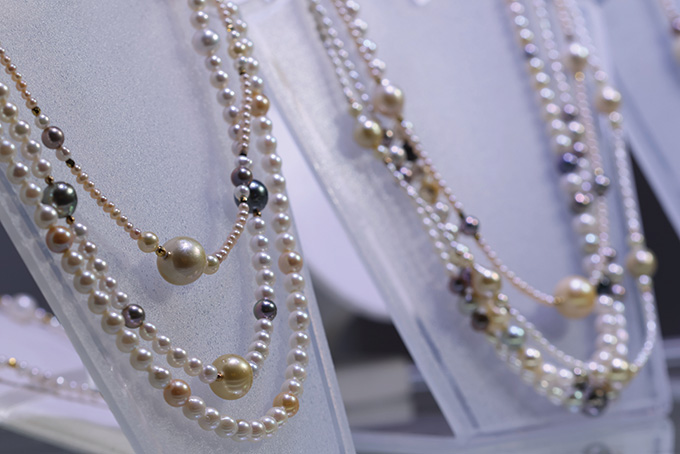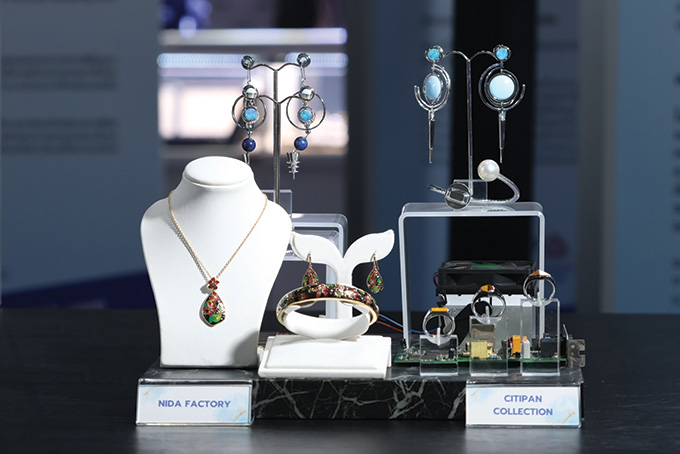The second Jewellery & Gem ASEAN Bangkok (JGAB) highlighted the strengths of Southeast Asia as a manufacturing and consumption hub, with buyers from the region and beyond fulfilling their sourcing requirements at the show.
This article first appeared in the JNA July/August 2024 issue.
Jewellery & Gem ASEAN Bangkok (JGAB) 2024 attested to the growing importance of Southeast Asia as both an accomplished manufacturing centre and a viable consumer base. ASEAN refers to the Association of Southeast Asian Nations.
According to fair organiser Informa Markets Thailand, the show welcomed over 10,730 participants over its four-day run at the Queen Sirikit National Convention Center (QSNCC) from May 1 to 4. This represented a 46 per cent increase over its maiden edition last year. The leading visitor markets were China, India, Myanmar, the Philippines, Sri Lanka, Vietnam, Singapore, Japan and Malaysia.
Sanchai Noombunnam, general manager of Informa Markets Thailand, said JGAB 2024 exceeded visitor targets and gathered 350 exhibiting companies from 12 countries around the world. These included China, Cambodia, India, Israel, Italy, Japan, Myanmar, Singapore, Sri Lanka, Türkiye and Thailand.
“JGAB 2024 underscores global buyers’ confidence in the jewellery and gemstone market of the Southeast Asian region, which is experiencing rapid growth comparable to global markets. It also highlights the potential of entrepreneurs, manufacturers and new designers who play a crucial role in continuously elevating market standards,” he said.
Southeast Asia
The show showcased the manifold opportunities and synergies in the Southeast Asian gem and jewellery sector.
In a session organised by the ASEAN Gems and Jewellery Trade Association (AGJA) on the sidelines of JGAB, Ermin Siow, vice chairman of AGJA and advisor of the Federation of Goldsmiths and Jewellers Associations of Malaysia, said the region was home to three of the world’s largest gold consumer markets, namely Vietnam, Indonesia and Thailand. In terms of gold jewellery consumption, Indonesia led the region in 2023 with 25.1 million tonnes, followed by Vietnam at 15.1 Mt and Malaysia at 11.3 Mt.
AGJA Chairman Suttipong Damrongsakul told JNA that the Southeast Asian countries complemented each other in the gem and jewellery space as both a manufacturing hub and a consumer market.
“With a population of more than 600 million, ASEAN can be the world’s next new market. We are double the size of the US and cover the gem and jewellery supply chain: Indonesia with gold, Myanmar with pearls, Thailand and Myanmar with coloured gemstones. We each have our own manufacturing strengths – Malaysia is a top exporter of 22-karat gold jewellery; Thailand excels in coloured gemstones and silver jewellery; and Indonesia is thriving as a jewellery production centre. ASEAN is the ideal trading hub for this sector,” he said.
Corundum demand
Product-wise, coloured gemstones were the stars of the show. Suppliers of rubies, sapphires, emeralds and other gems saw steady business at JGAB, positioned as the B2B jewellery trade fair for the fast-growing consumer markets of Southeast Asia. Interest however came from beyond the region as well, with exhibitors entertaining professional trade buyers from China, India, Europe and even as far away as South America.
Phuket Khunaprapakorn, managing director of corumdum specialist Gemburi Co Ltd and vice president for Thailand of the International Colored Gemstone Association (ICA), said he met serious buyers from China and observed the presence of more retailers at the show.
“Chinese visitors were eager to purchase rubies again, unlike at earlier shows this year where the Chinese market hesitated to make significant transactions. Several buyers were new to my company, so JGAB was quite productive for us,” he noted.
Visitors from China were seeking rubies in calibrated sizes, though prices for these goods remain high. Khunaprapakorn said buyers had come to terms with market realities that gemstone prices will not go down anytime soon and are now prepared to accept current rates and perhaps pass these on to their clients.
“Price increases are no longer as steep as in the last 12 to 18 months. This has increased buyer confidence in the market,” he explained.
The timing and location of the show contributed to its success, Khunaprapakorn continued. He said buyers usually prefer to make their gemstone purchases in Thailand so they can select among the finest stones before these hit international markets.
Pink calibrated sapphires were in demand at the booth of Fancy Factory Co Ltd, which specialises in fancy sapphires. Sales manager Teeratach Inworn touched base with buyers from India and Vietnam at the show. While many were existing clients, sales volumes had dipped compared to previous fair outings. In the past, the company would stock 600 carats worth of goods per size but this has now shrunk to a maximum of 200 carats as prices of sought-after goods have doubled in the past year, he shared.
Imran Shah, sales manager of Multi World Gems Manufactory Co Ltd, observed robust demand for coloured gemstones among jewellers and manufacturers from Asian markets such as Hong Kong, Taiwan and Thailand. He likewise entertained customers from further afield such as Russia and other European countries.
Jewellery manufacturers sought out good-quality calibrated rubies for their collections and some single stones for high-end jewellery pieces, while wholesalers, mainly from China, were buying single stones of 1 carat to 5 carats, Shah said. Particularly in demand were unheated, GRS-certified Pigeon's Blood rubies from Myanmar.
“While sales have not returned to pre-pandemic levels, business is picking up this year as customers have become more receptive to the prices,” Shah remarked.
Silver prospects
Silver jewellery, yet another of Thailand’s manufacturing stars, figured prominently on buyers’ shopping lists as well.
Hatai Gems & Jewelry Co Ltd presented the latest designs of its coloured gemstone jewellery set in gold-plated silver embellished with enamel. Here, too, ruby-accented jewellery pieces were in hot demand. Sales and marketing manager Yanida Siamwalla said these had caught the attention of buyers from Southeast Asia and even Japan and Ecuador, which are new markets for the company. “JGAB allowed us to make stronger connections with existing clients and potential customers. Visitors had the time to really examine the offerings of different companies and have meaningful discussions on current requirements but with an eye to long-term business relationships,” she disclosed.
Piyapoom Jewelry Co Ltd likewise forged new partnerships at JGAB with jewellery buyers from Australia, the US and Europe. By the second day of the show, company managing director Vibul Hongsrichinda had already finalised orders with several new clients.
“We are seeing strong demand for plated silver jewellery. Gold has been quite popular in recent months hence the market is gravitating towards silver pieces plated in yellow or rose gold,” said Hongsrichinda, who is also chairman of the Gem and Jewelry Industry Club, which represents the jewellery sector in the Federation of Thai Industries.
JGAB 2025 is scheduled for April 23 to 26 next year, also at the QSNCC.
















